Researchers at Rice University have created a thin coating of graphene nanoribbons in epoxy, that has proven effective at melting ice on a helicopter blade. This coating may be an effective real-time de-icing mechanism for aircraft, wind turbines, transmission lines and other surfaces exposed to cold weather. In addition, the coating may also help protect aircraft from lightning strikes and provide an extra layer of electromagnetic shielding.

The scientists performed tests in which they melted centimeter-thick ice from a static helicopter rotor blade in a -4 degree Fahrenheit environment. When a small voltage was applied, the coating delivered electrothermal heat - called Joule heating - to the surface, which melted the ice.
The GNRs were produced by unzipping nanotubes, in a process also invented at Rice. They are highly conductive, so rather than trying to produce large sheets of expensive graphene, the lab determined that these nanoribbons can be successfully used in composites. Previous experiments also showed how the nanoribbons could be used to de-ice radar domes and even glass, since the films can be made transparent to the eye.
The results of this study demonstrate, according to the researchers, that applying this composite to wings could save time and money at airports - where the glycol-based chemicals now used to de-ice aircraft are also an environmental concern.
In the lab tests, nanoribbons were no more than 5% of the composite. The researchers spread a thin coat of the composite on a segment of rotor blade supplied by a helicopter manufacturer; they then replaced the thermally conductive nickel abrasion sleeve used as a leading edge on rotor blades. They were able to heat the composite to more than 200 degrees Fahrenheit. The lab reported that the composite remained robust in temperatures up to nearly 600 degrees Fahrenheit.